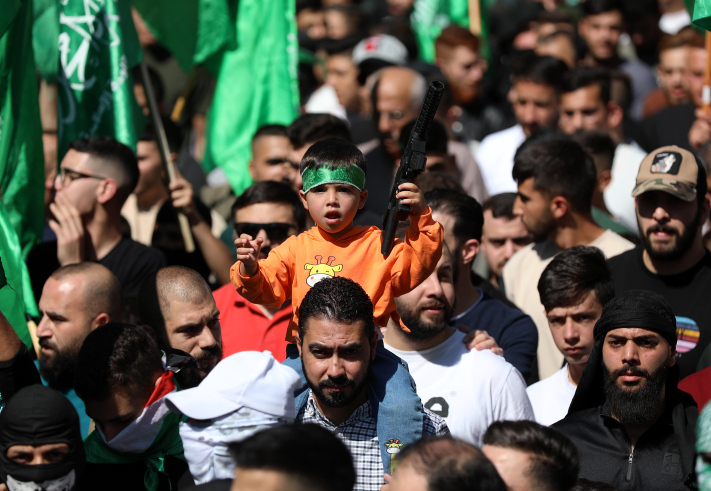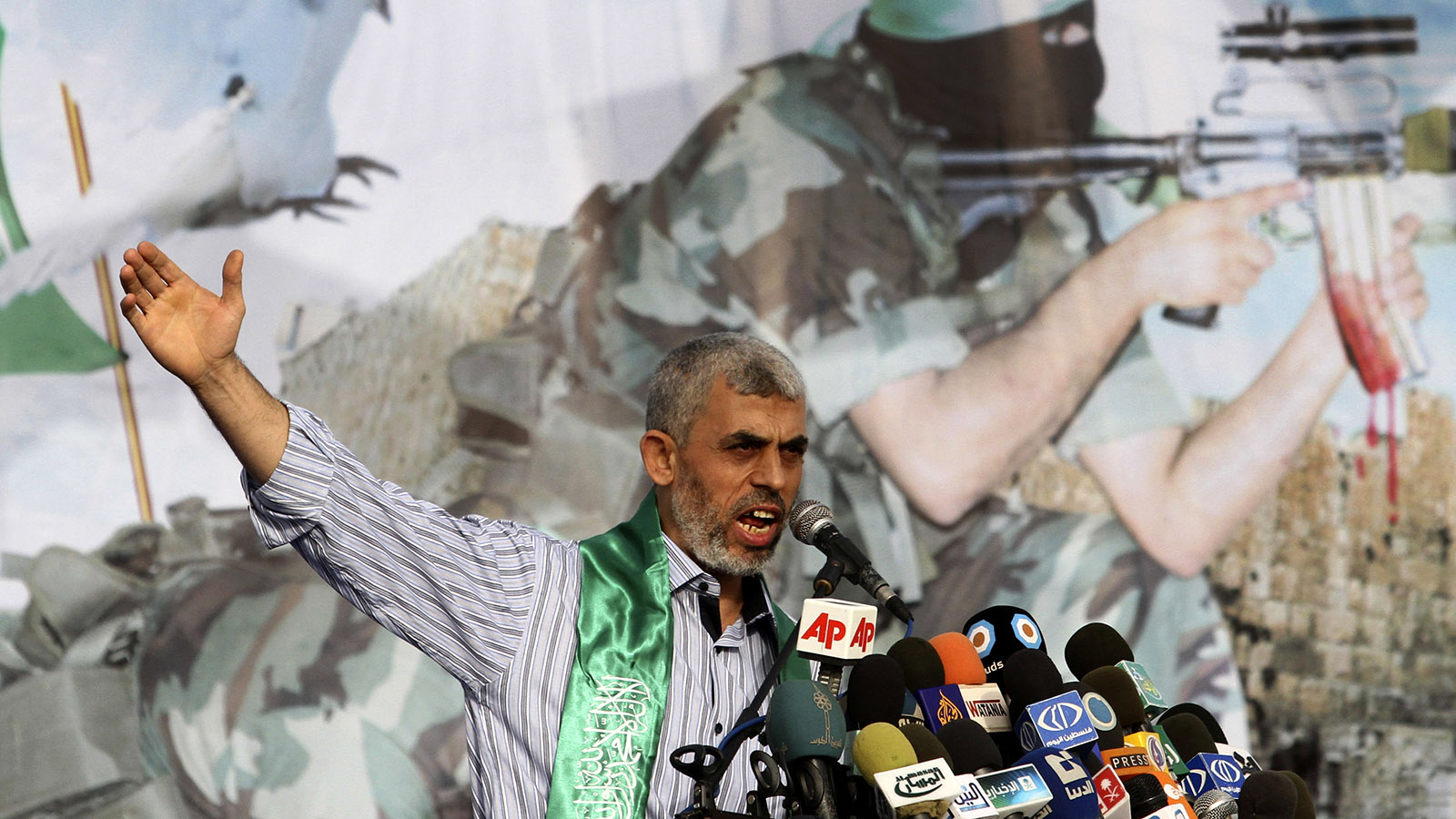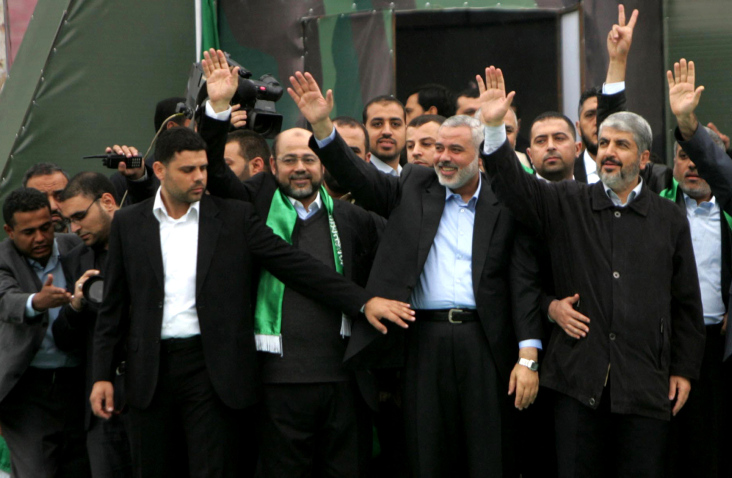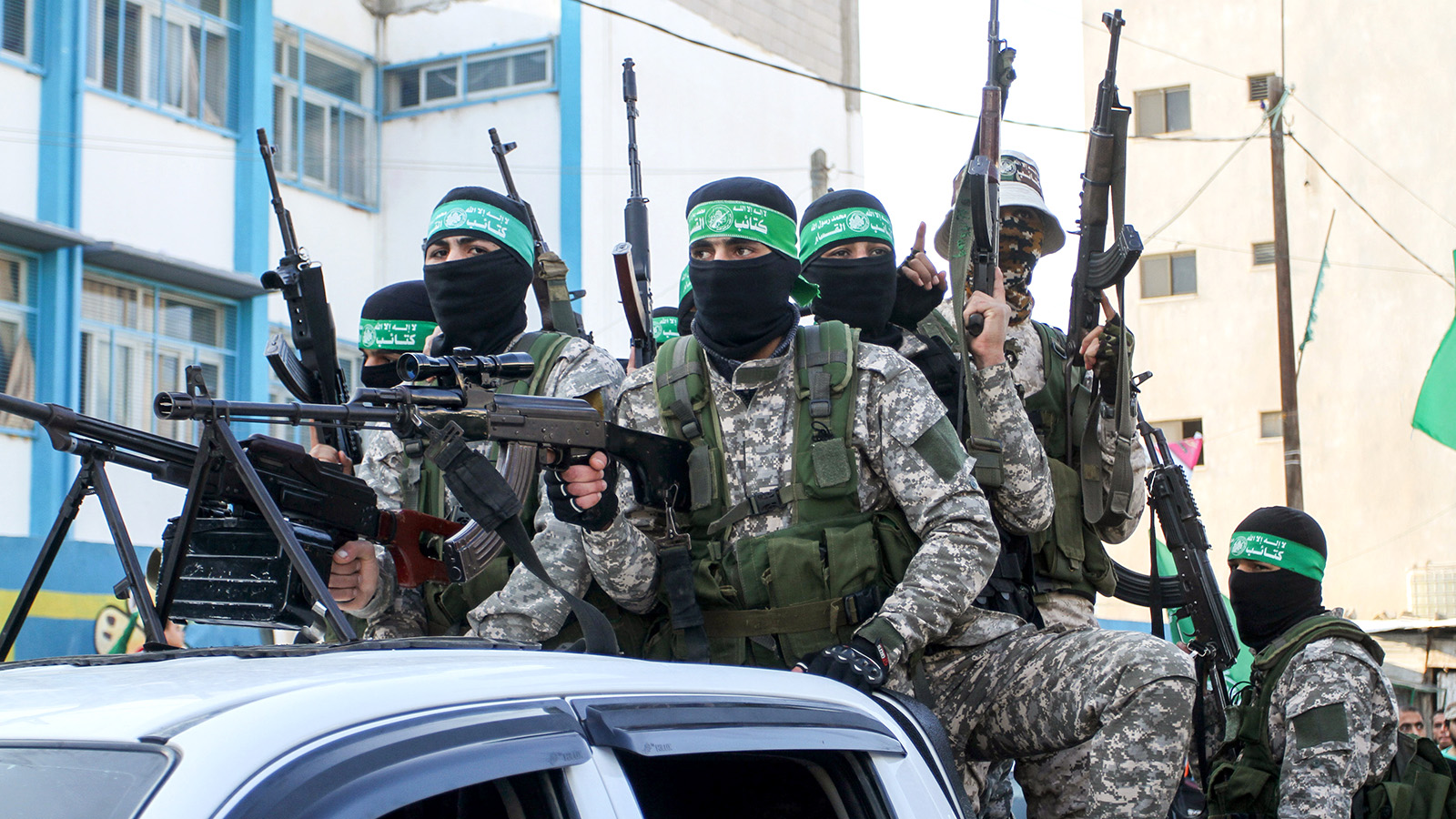
In the wake of Hamas’ Oct. 7 attack on Israel, which left 1,400 dead, more than 200 held hostage in Gaza, and thousands wounded, Israelis and people from around the world have been trying to understand more about the terror organization and the ideology behind its deadly assault.
Dr. Michael Milstein, head of the Forum for Palestinian Studies at the Tel Aviv University’s Moshe Dayan Center for Middle Eastern and African Studies, told Davar that news consumers should be wary not to overcomplicate Hamas’s motives. “Hamas has one overarching goal: to murder as many Israelis as possible,” Milstein said. “I hear people asking what Hamas was trying to achieve in the Oct. 7 attack, what the purpose of the attack was. We have to understand that there is no greater goal beyond what we saw.”
Col. (res.) Milstein served as advisor on Palestinian affairs to the Coordinator of Government Activities in the Territories from 2015-2018 and as head of the Palestinian arena in the IDF’s Military Intelligence Directorate. His last two books dealt with Hamas. In an interview with Davar, Milstein provided a comprehensive description of the Hamas movement and its various wings. He insisted that the starting point for the discussion should be the movement’s unity of purpose.
“Hamas’s mission is to murder, rape, kidnap,” Milstein said. “This is an organization that has been establishing itself for 35 years on a narrative of murdering Israelis. The name of the organization does not mention the word freedom or liberation of Palestine, but rather ‘moqawama,’ [the Arabic word for] resistance. And when we talk about resistance, we mean the murder of Israelis. At first, it was carried out by suicide bombing attacks, later by rocket fire, by attack tunnels. Hamas has upgraded its strength, its means, but the goal is the same.”
Milstein strongly criticized Western researchers of terror who try to make sense of Hamas.
“The researchers try to explain Hamas in Western terms and ideas. Sitting Hamas leaders in the psychologist’s chair or doing strategic analyses is a complete mistake,” he said. “You can't understand Hamas without using their language. This movement operates according to the logic of jihadist supremacy. And whoever carries out jihad is a martyr, that is, a suicide bomber who kills as many Israelis as possible. There is no dispute about this within Hamas, and there are really no other voices. The ultimate goal is to harm Israelis—and that's where the modus operandi is derived. Hamas perceives control of Gaza and internal government as tools for jihad. They do not carry out jihad in order to strengthen their regime, but strengthen their regime or harm it for the sake of jihad.”
According to Milstein, Hamas operates as a “four-headed monster,” with separate arenas in Gaza, the West Bank, Israeli prisons, and abroad.
“In each of the arenas there is a political bureau, which is a kind of government, and a shura or consultation council that operates under it,” he said. “This is a structure that we see in all the organizations that have come out of the Muslim Brotherhood. The decisions are made in the political bureau on the basis of ijma, which is reaching a consensus. A unanimous decision is made and the decision is binding on everyone. The shura council is composed of clerics who give religious validity to decisions made in the political bureau.”
Of the four arenas, Milstein explained, the heart of the Hamas movement is in Gaza.
“It is both where the organization was created and developed and the only place where the organization controls the population, budgets, and territory. If we said a four-headed monster, then the dominant head of the monster is Gaza, and the Hamas organizational structure is fully expressed in Gaza.”
Milstein noted, though, that this was not always the case and may not continue, especially if Israel reoccupies Gaza. “But over the past decade, there has been no doubt that Gaza has been the dominant center of power, and accordingly, Yahya Sinwar, who heads the political bureau in Gaza, is now the most influential factor in Hamas,” he said.

Milstein was careful to say that Sinwar is not necessarily the “leader” of Hamas.
“In fact, Hamas has no president or prime minister,” he explained. “Sheikh [Ahmed] Yassin, who founded Hamas, was such a supreme figure in his lifetime, a voice which everyone obeyed, not only by law or apparatus. After his death, there was no single leader left, and at different times we saw different figures occupy leadership positions. The power relations between the different leaders change over time and there is no one who can be determined to head the organization. In the end, decisions are made together by agreement—there is no single decision-maker from above."
Internationally, Hamas operates in Jordan, Lebanon, Turkey, Kuwait, and Qatar, Milstein said.
“In Lebanon, they have training camps and a military force that includes rocket launchers. The most important elements in Hamas abroad are members of the leadership that once sat in Damascus and is now based in Doha, the capital of Qatar,” he said. “Their roles are shaping strategy, gathering funds, resources, and weapons through diplomatic means. They are the suited arm of Hamas, in suits and with neat beards, and can be referred to as Hamas’ foreign ministry. In the past, the Hamas leadership abroad was more dominant, but in the past decade it has lost its lead to the leadership in Gaza.”
Milstein pointed to Khaled Mashal and Ismail Haniyeh as central figures in Hamas leadership abroad. "They have exchanged between them the positions of chair and deputy of Hamas’ high political bureau. Mashal has always been abroad, and Haniyeh previously served as Hamas leader in Gaza, and only a few years ago, after Sinwar defeated him in the Gaza elections, did he go abroad,” he said.

"These are people who have never held weapons, never sat in Israeli prisons. They don't know Israel from the inside like Sinwar,” he continued. “Sometimes we see that they are trying to refine Hamas in order to gain international legitimacy, but it would be a lie to claim that they are an opposition to Hamas’s murderousness. Other senior Hamas figures abroad are Musa Abu Marzouk, who is currently visiting Moscow, and of course Saleh al-Arouri.”
The US is offering a $5 million reward for anyone who helps bring al-Arouri to justice.
“Arouri is the one who led Hamas’s activity in the West Bank. He sits abroad and remotely manages the terrorist cells in [the West Bank]. In recent years, he has been the most significant figure in the connection between Hamas, Hezbollah, and Iran. This whole connection of the axis of resistance, the coordination between Hamas and Hezbollah and Iran, it’s all his work. The rockets from southern Lebanon, the attacks coming out of the West Bank—that’s him. The Americans have been pursuing him for several years.”
Milstein said that Hamas members in Israeli prisons used to have greater influence on the organization than they do now. “We don't have much information about the elections held there, because everything is done in secret. The influence of Hamas members held in prison on the entire organization is less than it used to be—at best they take their opinions into account. In the past, the prisoners were more central to the organization, but following the Hamas takeover of Gaza, the release of Arouri in 2007, and especially [the 2011 deal to free kidnapped Israeli soldier Gilad] Shalit, there were no high-level Hamas leaders left in prison.”
In the West Bank, Milstein said, there is wide support for Hamas, but the organization has no formal political mechanisms there. “This makes it an underground organization,” he explained. “The Israeli security forces work hard to thwart any organization, including the assassination of senior figures, which makes it difficult for Hamas to develop there. Most of Hamas’s leaders in the West Bank are in Israeli prisons, some in Palestinian prisons. The historical leader was Abdel Aziz al-Rantisi, who was assassinated in 2004, and later Arouri, who is based abroad."
Milstein said that Hamas manages to be a dominant force in the West Bank despite arrests and assassinations of its leaders and its lack of control of the government. He attributed the Palestinian Authority’s resistance to holding elections to their “fear that Hamas will take power.”
Between Gaza, the West Bank, Israeli prisons, and other Middle Eastern countries, the different branches of Hamas sometimes disagree, but they never lose sight of their central goal, Milstein said. “There is no dispute that murderous jihad is at the core of the organization’s work. In Hamas, unlike Fatah, there are no splits. If you get out of line, they take you out of the organization. There are no internal factions and no public arguments,” he said.
He described Gaza as Hamas’s most strategic asset. “Members of the political bureau in Gaza have the authority of a government,” he said. “It is no coincidence that the IDF eliminated five of them in the past three weeks. Among those killed was the chairman of the shura council, one of Gaza’s dignitaries.”
Milstein said that the main Hamas figures whose neutralization would be significant are Yahya Sinwar and Mohammed Deif. “Sinwar is the head of the political bureau, which makes him the political leader, and Deif is the head of the military wing,” he explained. “What we saw on Oct. 7 is their handiwork. This attack fits Sinwar's sadistic mind and Deif's command and coordination abilities very well. Sinwar is the brain, and he is the one who apparently motivated the martyrs. Deif is the operator—the one who plans, organizes and executes.”
Some critics say that Hamas might behave differently if it had a different leadership.
“In principle, Hamas in Gaza has a general conference, and almost open elections,” Milstien said. “In the last election, two years ago, some 20,000 Gazans participated. Nizar Awadallah almost managed to beat Yahya Sinwar. Sinwar won only after four rounds. Awadallah does not come from the military wing, and some identify him with the Ismail Haniyeh camp. It was Haniyeh who conducted the contacts with Israel and brought about the Shalit deal—that is, he is ready for some kind of negotiations with Israel. So there are claims that this is a pragmatic camp that may be willing to accept Israel even if they don't admit it.”
Milstein himself opposed this view. “It is possible that Awadallah would have tried to advance the development of the administration more, but even if he had won, Sinwar would have remained central and continued to invest full energy in perfecting jihad capabilities,” he said. “It should also be remembered that if Awadallah had pursued peace, he would not have been a candidate for head of the political bureau. We, as members of Western culture, have the need to search every nook and cranny for the pragmatic side, the leader with whom we can negotiate. I'm not sure there is one in Hamas. Maybe it's time we faced that possibility.
“Right now what we have in Gaza is Sinwar and Deif's Hamas,” Milstein continued. “It means extreme activism, an apocalyptic approach. The most important thing every day when you wake up in the morning is to promote the vision of the end times. Sinwar is a bloodthirsty man who loves death. He doesn't think about what class he'll enroll his child in and what he feels like eating at dinner. Nothing interests him except the blood of Israelis. For him, the struggle is conceptualized in absolute terms, as a war between the Sons of Light and the Sons of Darkness.”
Milstein also pointed to Marwan Issa as a key figure in Hamas in Gaza. “He is Sinwar's man and is responsible for the connection between the military wing and the political bureau, that is, between political activity and military activity,” he said. “Sinwar works in full synchronization with Mohammed Deif, the head of the military wing who was formerly his commander. Deif is that kind of person who finds solutions to things. He does not have the strategic stature. He does not ask himself what he wants Hamas to look like 10 years from now, but goes down to the ins and outs of how to operate the attacks on Israel. Control of forces, coordination of military efforts.”

Milstein speculated that Hamas leaders from abroad knew about the planning in advance. “On the morning of Oct. 7, they sat together in Doha. There was Haniyeh, Arouri, Mashal, and also Khalil El Basha, who is from Gaza, Sinwar's deputy. The very fact that he is with them in Doha indicates that they knew,” he said.
“They sit together like a command post to manage the event strategically and diplomatically,” he continued. “As soon as the TV turns on and you see the pictures, they burst into cheers and prayers of thanksgiving. This is an event unparalleled in the history of Hamas: the largest and most important attack by the organization since it was founded.”
Milstein spoke of the importance of the close connection between Hamas and Qatar.
"Qatar is completely identified with Hamas,” he said. “It is a tool in the hands of Hamas and uses Hamas to position itself as an influential regional player. The Hamas leadership manages its strategy from Doha. Every day there is activity to raise funds for Hamas in Doha. Al Jazeera uses its enormous power to promote Hamas.”
“Hamas has no disputes about Qatar,” he continued. “For them, Qatar is like a big sister. It should be noted that Hamas is a sovereign organization, it does not do whatever the leaders of Qatar say, but as an organization it relies on Qatar.”
Israel is now in a complicated position regarding Qatar, Milstein said, because Israel will need to rely on Qatar to negotiate a hostage release deal. “It is clear that Qatar in its cynicism will know how to take full advantage of this,” he said. “The day after, I recommend keeping Qatar as far away from Gaza as possible. Israel must cut this relationship between Hamas and Qatar by all means. It would be better for us that the influential elements in Gaza be Egypt, the United Arab Emirates, and Saudi Arabia.”
Milstein said that relations between Hamas and Iran are at a peak, having known years of ups and downs. “This is done through a lot of work by Arouri, as I mentioned before,” he said. “Hamas has gained much from this relationship, which is now being tested. The more Israel moves forward in eliminating Hamas, the more we will know how much Iran cares for it as it promised.”
This article was translated from Hebrew by Leah Schwartz.






